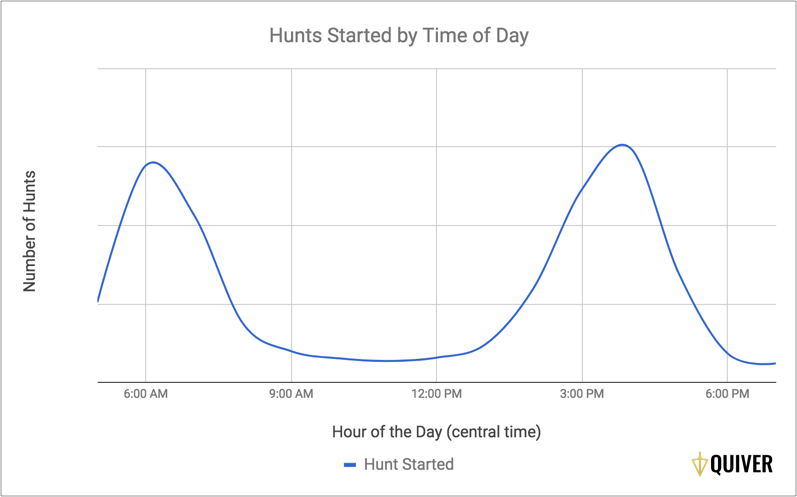Best Times to Hunt
As hunters, we’re always trying to better understand deer movement in our area to find the best time to hunt. If you’re like most guys and gals out there, you have limited time in the stand, and you need to pick and choose which days and times you think are the best to get out.
When is the best time of day to hunt?
That my friends is the proverbial question on each hunter’s mind. Do I start hunting the mornings, is it an afternoon sit, or am I in full day grind mode and spending all day up in the tree?
At Quiver, that’s why we exist. To help you better understand deer movement in your area. Not only at the individual level when you’re out using the app to track your hunts, but also in aggregate, as we look at patterns and trends across all the data (anonymized and private of course) to help you become a better hunter.
Each day out in the field and scenario is different, but we’ve taken a look at all the data logged in Quiver from the last two seasons to try and help answer some of those questions. When digging into this, there were some surprises that support some known theories out there, so please read on to learn more.
So when do hunters see the most deer?
For this analysis below, we looked at all hunts logged in Quiver for the last two season (2015 & 2016) during the months of October and November.
Just to give you a scale of the data, above is a graphic of all the hunts tracked in Quiver. As you can tell, our focus is on the whitetail community given the geographic spread of hunters.
For those of you new to Quiver, you can learn more about it here, but as a quick intro, it’s a mobile hunting app that allows you to track your hunts. You can record when deer move, take photos and monitor key weather. All the data below is based on what our users have tracked in the app over the last two seasons.
So now the analysis on deer movement…
Below is a chart showing the time of day that every hunt was started in the app in the months of October and November between 2015 - 2016. As you’d expect, most hunters are either going out in the morning or in the afternoon, which are the typical times that hunters target. It makes sense because that’s when deer are most often moving between bedding and feeding.
As a result of more hunters out in the woods in the mornings and evenings, we’d expect to see more deer logged in the app at these times. The data follows that same trend as we see more buck and doe sightings logged in the app within the same morning and evening time windows below.
Now this story gets really interesting when we start to look at the average amount of deer seen by the hour. Above, the charts were all totals, and the total deer seen was a result of the amount of hunters out in the field at that give time. However, when we start to look at the average amount of deer seen by the hour, a new insight emerges as we see the afternoon peak for the average amount of deer seen for both bucks and does.
Notice the chart rise in the middle of the graph between the hours of 10 and 2 PM. I’ve always heard guys talk about that afternoon sit and how it can be a deadly time to catch bucks cruising. Well, this data supports that.
As the analysis reveals, most hunters are typically targeting those morning and evening sits but very few are going after that lunch time sweet spot. You might want to reconsider that on your next hunt, and as my good buddy Nick recently told me, hunt the T’s - ten to two.
Hunt the T’s: Ten to Two
Thanks for reading this post. If you’re interested in trying out Quiver, you can download it for free at the iTunes for FREE and use it to track your next hunt.






